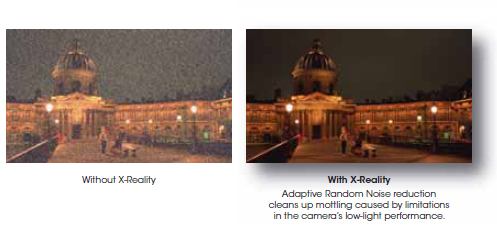You’ve likely heard about Sony’s X-Reality Pro Engine, and the latest version for 4K TVs. But what exactly does it do, and how does it work?
The best way to describe this picture engine is as an intelligent processor/scaler. It takes video or picture content, whether it’s a television show, news, sports, a Blu-ray disc or DVD, or home movie, and upscales it to improve the picture when it’s displayed on a television that’s capable of producing higher-resolution images.
In simple terms, the Engine does this by analyzing and refining every pixel of the image, comparing it against an internal database, then essentially rebuilding it, capturing pixels and image detail that was lost in the translation from lower resolution to higher.
 The process can be likened to a professional artist or restorer working their magic to restore a photo or painting back to its original, true beauty, adding back missing elements, and retouching areas that may have lost their lustre, or aren’t quite as bright and vibrant as they used to be. The Engine acts like that capable artist, analyzing and studying the image and selecting the proper colours, textures, and tones to recreate it as naturally and beautifully as possible.
The process can be likened to a professional artist or restorer working their magic to restore a photo or painting back to its original, true beauty, adding back missing elements, and retouching areas that may have lost their lustre, or aren’t quite as bright and vibrant as they used to be. The Engine acts like that capable artist, analyzing and studying the image and selecting the proper colours, textures, and tones to recreate it as naturally and beautifully as possible.
It is especially useful if you want to view videos taken with a smartphone, for example, home movies shot in HD, or low-resolution YouTube videos played back on a large-screen 4K TV. Without this upscaling process, while the content might look fine on a small screen, or even a laptop or HD TV, the extra pixels in a 4K television can result in a sub-par image with lost detail that makes it unwatchable.
With an outdoor scene, for example, viewing a low-resolution image might result in the trees in the background looking like a big, green blob. Through the upscaling process, the full image is analyzed, missing detail filled in for the foliage, and voila! The leafy details you could clearly see on your phone, or via YouTube on the computer screen, appear once again.
 How does it work?
How does it work?
The process occurs in three steps: image analysis, noise reduction, and reality creation. It analyzes pixels, comparing them to one another, compares patterns of pixels to an internal database, and restores detail that’s lost in the transmission to this new high-resolution source display.
The processor uses a chip to enhance the image, using pattern analysis and reality creation to compare every intricate detail of a pixel to those around it, including height, width, diagonal motion and time, frame-to-frame, to check for changes. It then uses an intelligent database and algorithms to adjust colour, saturation, brightness, contrast, and sharpness, and reduce noise (specks or graininess), to result in an improved picture.
In the latest version of the Engine for 4K TVs, there are other technologies going on in the background, including statistical learning that continuously compares 2K images versus 4K to determine the correlation, and make intelligent adjustments. (The X-Reality Pro Engine is also found in 1,080p TVs, upscaling low resolution images there for improved display as well.)
Bottom line
Think of Sony’s X Reality Pro engine as a behind-the-scenes technique to restore images when they’re displayed on a high-resolution screen. It works to ensure that as much detail as possible is captured and retained to reproduce an image as close to the original as possible.
You’ll find and extensive selection of Sony’s latest televisions online at BestBuy.ca



